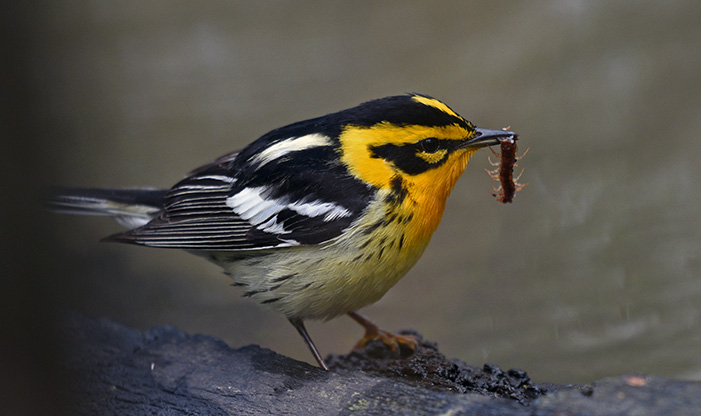Birds search for food using a variety of foraging methods depending on what they eat. It can sometimes be challenging to see how small birds forage, but learning about their physical traits and behaviors can help. Take note of some of the characteristics common to local birds who forage on plant food, such as seeds, fruit, and nectar, as well as those who forage on insects and other invertebrates. It will help you identify them and how they find food.
The Effect of Bill Shape on Foraging
When foraging on plant sources, one important factor in determining how birds obtain nutrition is bill shape. Some birds, such as American Robins and Cedar Waxwings, have bills ideal for eating small fruits and berries. Ruby-throated Hummingbirds insert their long bills into tubular-shaped flowers to feed on nectar.
Seed-eating birds, like finches, show a great diversity of behavior and bill shape. Birds in the sparrow family display a characteristic thick, triangular shaped bill used for cracking seeds. Some sparrows, like Eastern Towhees, forage on the ground using a double scratch method. Jumping straight up, they swing their feet forward then rake backwards against the ground, kicking out leaves and debris. Then they search the ground to see what food they may have uncovered.
Black-capped Chickadees are frequent visitors to bird feeders, where they may fly off with a seed to store in a hidden location. This behavior is called caching. During a harsh winter, a chickadee may store thousands of seeds in a process called scatter hoarding, tucking food into tree crevices or anywhere they can hide it for later retrieval.
The Importance of Insects
Insects become a more common food source in the warmer months. Birds use a variety of techniques to catch insects to feed themselves and their young. Gleaning is a method used by birds to pick insects off leaves, branches, or other surfaces. This can be done in several ways. Many warblers, like the Blackburnian Warbler pictured, use perch gleaning, when a bird grabs prey while remaining on a perch. Red-eyed Vireos and chickadees often utilize sally gleaning, watching nearby vegetation for movement. When an insect is located, the bird flies out to grab it. Some birds, such as kinglets and Great Crested Flycatchers, practice hover gleaning, in which the bird will actually hover over the vegetation, picking food from the surface.
Aerial insectivores, such as Barn Swallows and Chimney Swifts are often seen flying over ponds and open fields where they are adept at catching insects in midair. Many flycatcher species, including Eastern Phoebes and Eastern Kingbirds use the technique called hawking, in which a bird waits on a perch, flies out to catch an insect from the air, and returns to the same perch.
Some birds probe with their beaks to find insects and other invertebrates. Woodpeckers provide an excellent example of this, as we see them hammer into a tree to find invertebrates like beetle larvae, ants, and caterpillars. Brown Creepers maneuver up tree trunks as they probe, peck, and glean insects from crevices in the bark, while White-breasted Nuthatches also probe tree trunks, but tend to work their way down the tree. American Woodcocks use their long, straight bill to explore the forest floor in search of earthworms and other food.
Foraging on Mixed Food Sources
Many birds are able to forage for both plant-based sources of food as well as insects. Black-capped Chickadees have an assorted set of foraging skills. Their diet consists of both plant and animal sources including seeds, berries, insects, spiders, and caterpillars, among others. Yellow-rumped Warblers are adept at catching insects with their thin bills as well as picking fruit small enough for them to eat, such as poison ivy berries.
When you visit the Center, observe birds at the feeders, on tree trunks, near vegetation, or in the sky while you’re on our trails. If you look closely at the birds’ behavior, try and notice all the different foraging methods you can identify.


